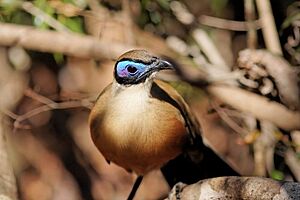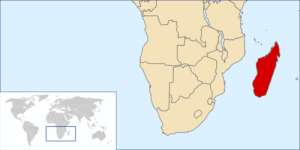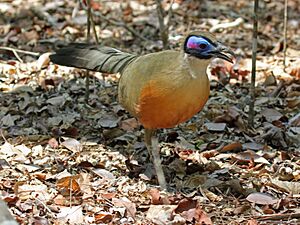Giant coua facts for kids
Quick facts for kids Giant coua |
|
|---|---|
 |
|
| Conservation status | |
| Scientific classification | |
| Genus: |
Coua
|
| Species: |
gigas
|
 |
|
| General Range of giant coua in Madagascar | |
The giant coua (Coua gigas) is a large, colorful bird. It belongs to the cuckoo family. This bird lives only in the dry forests of western and southern Madagascar. Scientists think couas might have come from a type of ground-cuckoo in Asia. There are 10 different kinds of couas, which is more than any other bird group in Madagascar. Even though the giant coua is listed as "least concern" by the IUCN Red List of Threatened Species, it only lives in Madagascar. This makes it an important bird to protect globally.
Contents
About the Giant Coua's Name
The giant coua was first described by a French scientist named Georges-Louis Leclerc, Comte de Buffon in 1780. Another scientist, Pieter Boddaert, gave it the scientific name Cuculus gigas in 1783. Today, it is part of the Coua group. This name comes from koa, which is the Malagasy word for these birds. The word gigas means "giant" in Latin. This fits the bird's large size.
What Giant Couas Look Like and Do
Giant couas are about 62 centimeters (24 inches) long. This makes them almost twice as big as some other coua species. They have a bright blue patch around their eyes. This blue patch is common for birds in the coua group.
Like other cuckoos, they have a special third toe that can point backward or forward. This helps them climb easily. They move through thick vines and trees to find food. They can climb as high as 10 meters (33 feet) off the ground.
What Giant Couas Eat
Giant couas eat seeds from certain trees. They also eat insects and small animals like chameleons. These birds often live in large, undisturbed forests with tall trees. They prefer places without many dense bushes, which makes it easier for them to move around.
Their eating habits can change with the seasons. In dry seasons, they might pick food off surfaces. In rainy seasons, they might jump and catch flying insects. This shows how much their environment affects how they find food. They tend to use parts of the forest with more tree cover. They also look for food in taller parts of the forest.
Where Giant Couas Live
You can find Coua gigas in the lowlands of western and southern Madagascar. They live in areas up to 700 meters (2,300 feet) high. The area where these birds live is quite large. It is estimated to be between 50,000 and 100,000 square kilometers (19,000 to 39,000 square miles).
Scientists have not counted the exact number of giant couas. However, they are thought to be common in some parts of their home range. Their population numbers are not declining quickly. This is why they are listed as a species of "least concern" by conservation groups.
Protecting the Giant Coua
Even though the giant coua is not highly endangered, it still needs protection. Sometimes, people hunt these birds. Fires and logging can also harm their homes. When humans change the forest, it affects where the birds can live and find food.
Logging, which is cutting down trees, is a big problem for birds like the giant coua. It reduces the number of these birds in an area. More logging or fires could shrink their best habitats. This would lead to fewer giant couas. It is important for conservation groups to make sure these birds have enough different types of food sources.
Protecting the forests helps the giant coua. Limiting logging in dry forests and keeping gallery forests safe are good steps. Gallery forests are strips of trees along rivers. These can act as safe paths for birds. Controlling fires in both types of forests is also very important.
Recent observations in Sainte Luce, Madagascar, show that some giant couas there have longer tails. This suggests there might be small differences between groups of these birds. Sainte Luce is a good place to see giant couas. Managing these forest areas for a long time can help the birds. This region also has potential for eco-tourism. This means people can visit to see the birds and help support their protection.
See also
- Endemic birds of Madagascar and western Indian Ocean islands



